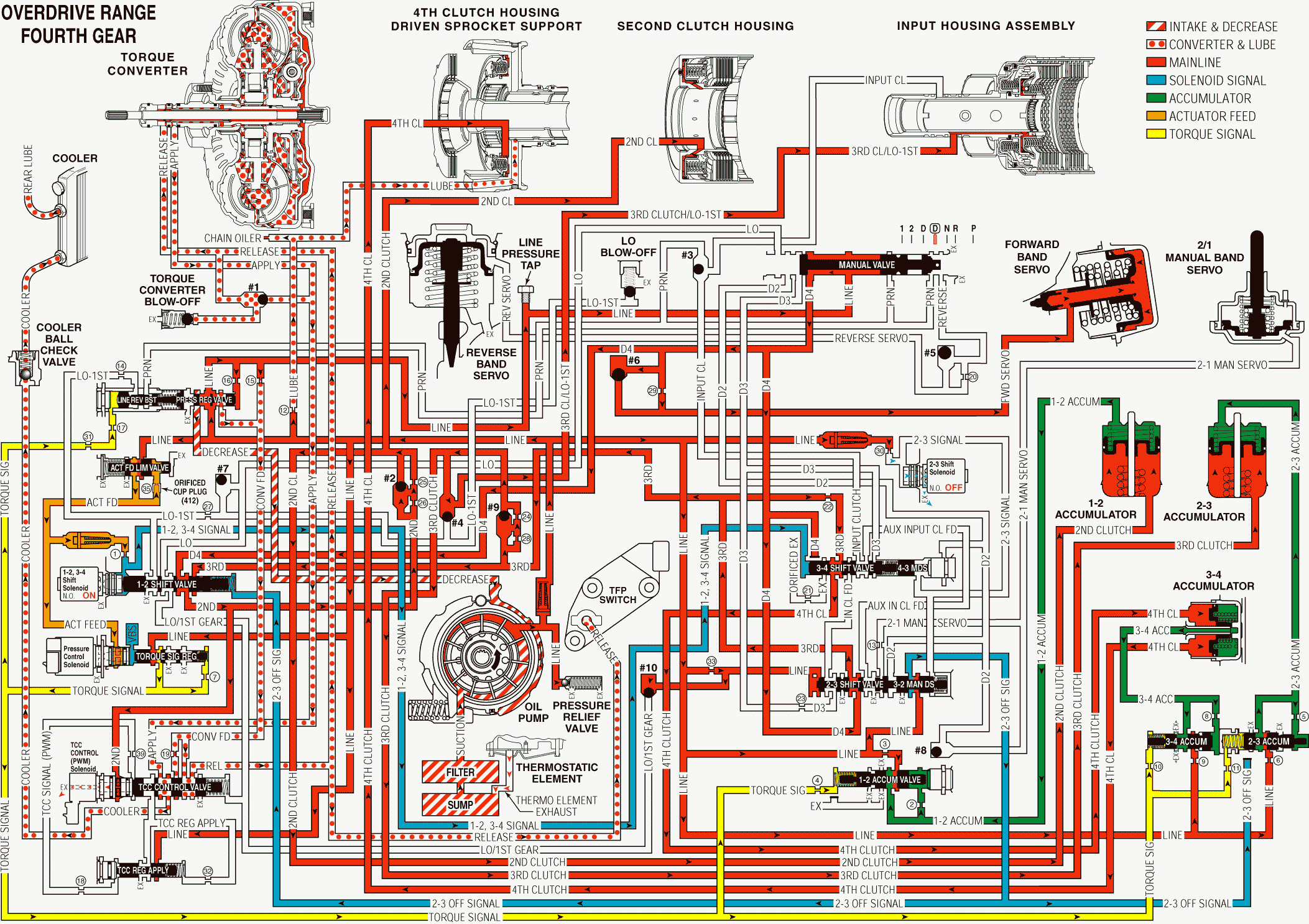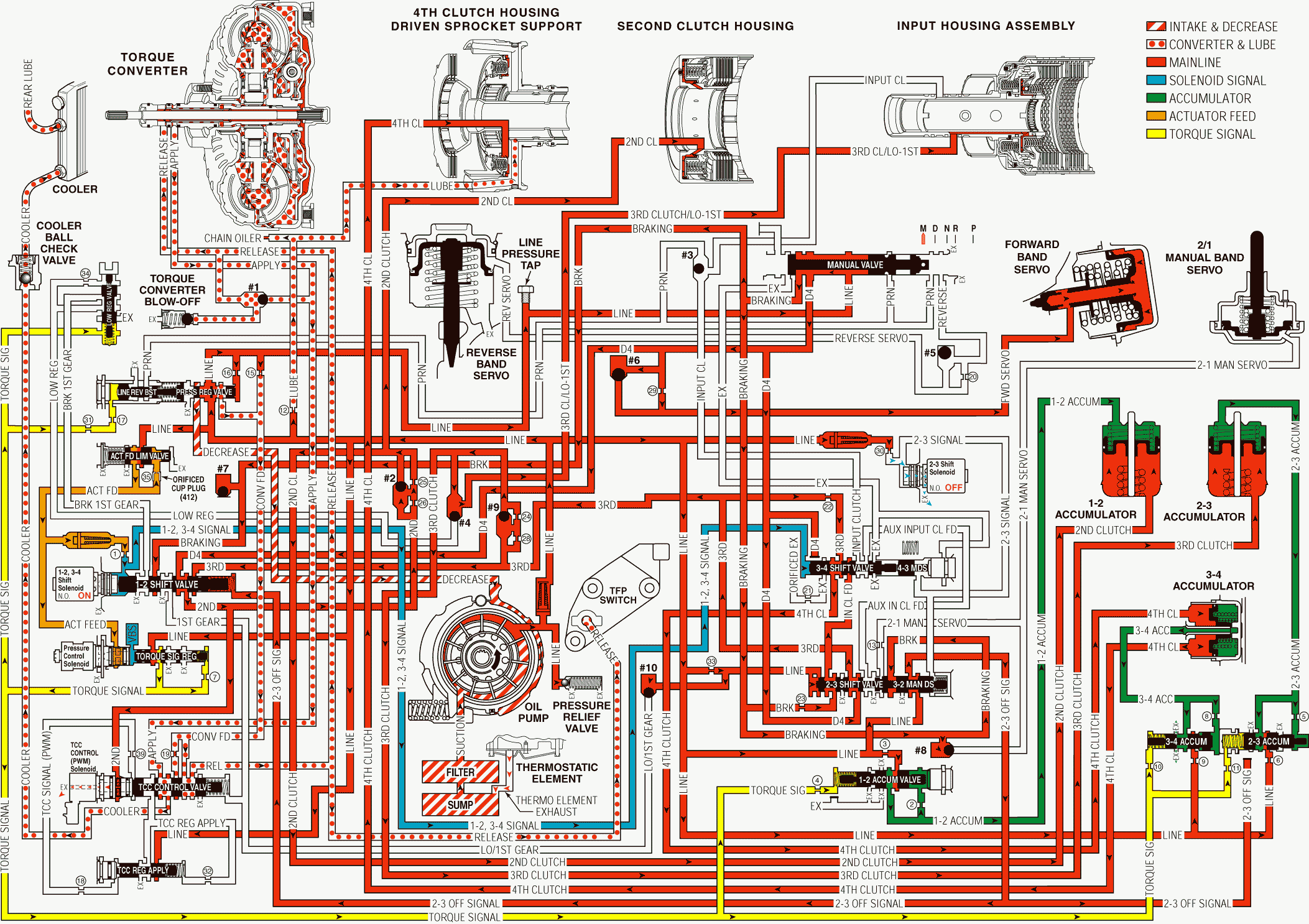Overdrive Range, Fourth Gear - Torque Converter Clutch Not Applied Without Touch Activated Power
As the speed of the vehicle continues to increase, the powertrain control module (PCM) monitors the input signals from various engine and transmission sensors. The PCM uses this data to energize the 1-2, 3-4 shift solenoid (SS) valve in order to shift the transmission into fourth gear at the appropriate time.
1-2, 3-4 Shift Solenoid (SS) Valve (315)
Energizes to prevent fluid from exhausting out of the line passage and the 1-2, 3-4 signal fluid passage.
1-2 Shift Valve (318)
Is held against 1-2, 3-4 signal fluid pressure by spring pressure and 2-3 off signal fluid pressure at the end of the valve.
3-4 Shift Valve (362)
When 1-2, 3-4 signal fluid shifts the 3-4 shift valve against spring force, it allows 3rd fluid to enter the 4th clutch fluid passage. 4th clutch fluid is forced through a feed orifice before stroking the 3-4 accumulator piston (428) and applying the fourth clutch.
Fourth Clutch
4th Clutch fluid pressure applies the fourth clutch to shift the transmission to fourth gear.
Third Clutch
Remains applied, but is ineffective.
Third Roller Clutch
Overruns as fourth clutch is applied. In third gear, the input clutch is released allowing input clutch apply fluid to exhaust through the 3-4 shift valve (362) into the input clutch feed passage. At the 2-3 shift valve (357), exhausting input clutch apply fluid is directed into the D3 passage and out the manual valve (404).
Second Clutch
Remains applied.
Forward Band
Remains applied, but is ineffective.
1-2 Support Roller Clutch
Continues to overrun.
3-4 Accumulator
4th clutch fluid is also routed to the 3-4 accumulator piston. 4th clutch fluid pressure moves the piston against spring force and 3-4 accumulator feed fluid pressure. This action absorbs initial 4th clutch fluid pressure to cushion the 4th clutch apply. The movement of the 3-4 accumulator piston forces some accumulator fluid out of the accumulator.
3-4 Accumulator Valve
Excess 3-4 accumulator feed fluid is routed back to the 3-4 accumulator valve. This fluid pressure moves the accumulator valve against spring force and torque signal fluid pressure to regulate the exhaust of excess accumulator fluid. This regulation provides additional control for the fourth clutch apply.
Torque Converter Clutch
TCC apply could vary depending on vehicle application and may be calibrated to apply in Overdrive Range -- Fourth Gear.
Transmission Fluid Pressure (TFP) Manual Valve Position Switch
Release fluid pressure routed to the TFP manual valve position switch signals the PCM that the TCC is released.
Overdrive Range, Fourth Gear - TCC Not Applied - Without Touch Activated Power

Overdrive Range, Fourth Gear - Torque Converter Clutch Not Applied With Touch Activated Power
As the speed of the vehicle continues to increase, the powertrain control module (PCM) monitors the input signals from various engine and transmission sensors. The PCM uses this data to energize the 1-2, 3-4 shift solenoid (SS) valve in order to shift the transmission into fourth gear at the appropriate time.
1-2, 3-4 Shift Solenoid (SS) Valve (315)
Energizes to prevent fluid from exhausting out of the line passage and the 1-2, 3-4 signal fluid passage.
1-2 Shift Valve (318)
Is held against 1-2, 3-4 signal fluid pressure by spring pressure and 2-3 off signal fluid pressure at the end of the valve.
3-4 Shift Valve (362)
When 1-2, 3-4 signal fluid shifts the 3-4 shift valve against spring force, it allows 3rd fluid to enter the 4th clutch fluid passage. 4th clutch fluid is forced through a feed orifice before stroking the 3-4 accumulator piston (428) and applying the fourth clutch.
Fourth Clutch
4th Clutch fluid pressure applies the fourth clutch to shift the transmission to fourth gear.
Third Clutch
Remains applied, but is ineffective.
Third Roller Clutch
Overruns as fourth clutch is applied. In third gear, the input clutch is released allowing input clutch apply fluid to exhaust through the 3-4 shift valve (362) into the input clutch feed passage. At the 2-3 shift valve (357), exhausting input clutch apply fluid is directed into the D3 passage and out the manual valve (404).
Second Clutch
Remains applied.
Forward Band
Remains applied, but is ineffective.
1-2 Support Roller Clutch
Continues to overrun.
3-4 Accumulator
4th clutch fluid is also routed to the 3-4 accumulator piston. 4th clutch fluid pressure moves the piston against spring force and 3-4 accumulator feed fluid pressure. This action absorbs initial 4th clutch fluid pressure to cushion the 4th clutch apply. The movement of the 3-4 accumulator piston forces some accumulator fluid out of the accumulator.
3-4 Accumulator Valve
Excess 3-4 accumulator feed fluid is routed back to the 3-4 accumulator valve. This fluid pressure moves the accumulator valve against spring force and torque signal fluid pressure to regulate the exhaust of excess accumulator fluid. This regulation provides additional control for the fourth clutch apply.
Torque Converter Clutch
TCC apply could vary depending on vehicle application and may be calibrated to apply in Overdrive Range -- Fourth Gear.
Transmission Fluid Pressure (TFP) Manual Valve Position Switch
Release fluid pressure routed to the TFP manual valve position switch signals the PCM that the TCC is released.
Overdrive Range, Fourth Gear - TCC Not Applied - With Touch Activated Power

